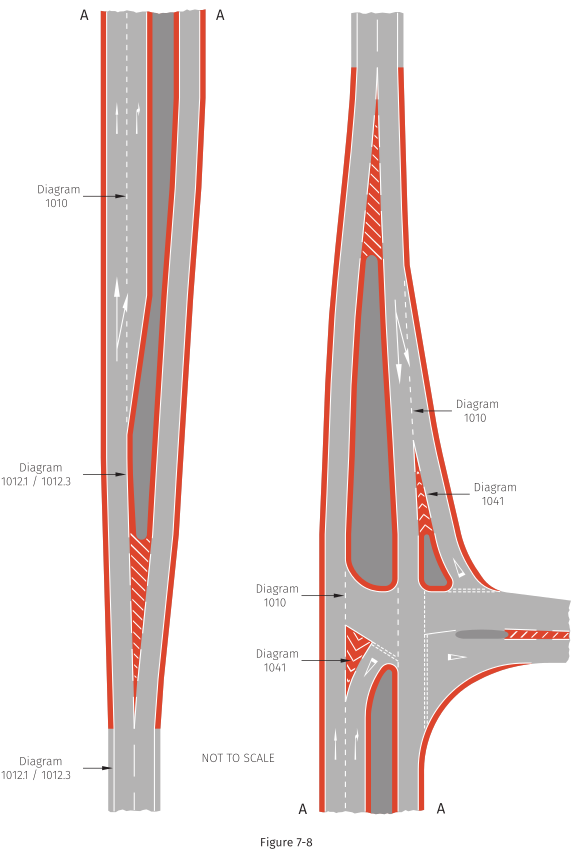A frequent and recurring debate that crops up in driving circles relates to the national speed limit for a dual carriageway. I’m not referring to the erroneous belief that it is on an unlit, or otherwise suitably subject to a ‘derestriction’ Order, 60 mph. It is, in fact, for cars at least, 70 mph; the exact same as motorways despite the latter usually being constructed to a far higher specification.
No, the debate I refer to is regarding what goes down the middle of a dual carriageway. The simple answer is it’s something solid. That means that four lane roads (where traffic is divided merely by painted lines) are not dual carriageways and if they are subject to the upper national speed limit it is indeed 60 mph and not 70 mph.

This four lane single carriageway, part of the A556 in Cheshire, has explicit 60 mph signs to remind drivers that it is not a dual carriageway. Traffic Signs Manual Chapter 3 states that 60 mph signs are for dual carriageway roads only; which makes me wonder if this arrangement is subject to a special direction or has it just been done on the fly to try and be helpful.

Compare with this elderly section of the dual carriageway A1 in Bedfordshire, which also has a 60 mph speed limit (and average speed cameras!).
So, now we have ruled out single carriageways with several lanes from the debate, that leaves us with the official legal definitions of a dual carriageway:
TSRGD 2016 tells us:
|
“central reservation” |
(a)
any land between the carriageways of a road comprising two carriageways; or (b)
any permanent work (other than a traffic island) in the carriageway of a road, which separates the carriageway or, as the case may be, the part of the carriageway, which is to be used by traffic moving in one direction from the carriageway or part of the carriageway which is to be used (whether at all times or at particular times only) by traffic moving in the other direction |
|
“dual carriageway road” |
a road which comprises a central reservation and “all-purpose dual carriageway road” means a dual carriageway road which is not a motorway |
So far so good? No, think again. A spanner is then thrown into the works by the wording of Traffic Signs Manual Chapter 4, which tells us:
On a single carriageway road which widens to a dual carriageway for a length of at least 400 metres, an advance sign to diagram 818 should be provided. Siting distances, normally measured back from the nose of the central hatch marking at the start of the dual carriageway, are similar to those indicated in Appendix A for warning triangles. If the dual carriageway is shorter than 400 metres, no advance sign should be provided. The sign to diagram 818.1A may be used to warn drivers that a dualled length is short and so might not be long enough to permit overtaking. The sign may display distances of “¼ mile“ or “½ mile” only.
So this now suggests that we should only sign dual carriageways with the advance information sign to Dia. 818 if the length of the central reservation is greater than 400 metres, in order to discourage overtaking at shorter lengths where there is a serious road safety hazard. Another spanner now; the Traffic Signs Manual cannot override the primary legislation so the TSRGD definitions still apply. Let’s return to that for a moment.
(b)any permanent work (other than a traffic island) in the carriageway of a road
This is the definition I have an issue with. Traffic island is not defined but I suspect we all take it to mean either a pedestrian refuge or a short permanent feature to deter overtaking on wide single carriageways. Note that, crucially, no minimum length is given for permanent work in the carriageway. As this is a statutory definition, the lawyers might have a field day with this one trying to fathom out exactly what is ‘permanent work’
There is one situation where I am not particularly comfortable with the speed limit rising to 70 mph, and this at those situations where ‘single lane dualling’ has been provided. The Design Manual for Roads and Bridges now explicitly prohibits the use of a ‘full’ dual carriageway purely at junctions on otherwise single carriageway roads, which makes sense on safety grounds; the very last place you want traffic to speed up and start overtaking is in the vicinity of a junction after all.

A typical layout for single lane dualling, as demonstrated in Traffic Signs Manual Chapter 5. The big question, are those dark grey areas shown in the drawing long enough to constitute more than a traffic island, and thus raise the speed limit to 70 mph?

This single lane dualling on the A69 is signed as an explicit 60 mph speed limit. If the single lane dualling here constitutes a dual carriageway as per the TSRGD, then there should be Dia. 670 (60 mph) roundels at the start of the section, and Dia. 671 (national speed limit applies) roundels at the end because a Speed Limit Order is needed to reduce the single lane section from 70 mph to 60 mph. The Dia. 671 signs are not present, which means this is incorrectly signed.
I think I am justified in suggesting that very few engineers would ever sign the approach to a single lane dualling arrangement at a junction with Dia. 818. This, therefore raises a point; if Chapter 4 says that a dual carriageway should only be explicitly signed as such if it is longer than 400 metres, then what does this mean for those lengths shorter?
No signs; no dual carriageway? Just an elongated traffic island?
OK, let’s get serious for a moment. It may very well be that I am just being a little bit pedantic, as in reality speed limits increasing at a short central reservation isn’t likely to cause anyone to get caught speeding, but in an industry where we require certain aspects to be subject to a strict definition, not actually being told the point when a traffic island ceases to be that and becomes a dual carriageway is a bizarre situation.
I have, unsurprisingly, raised this issue and there is a difference of views, which is understandable. The main objection is, does it really make much difference if someone continues at 60 mph instead of 70? Is it worth changing legislation just for that? Probably not. What may be an issue is someone seeing a Dia. 818 and choosing to overtake, even if the road layout is actually single lane dualling and thus no opportunity to overtake actually exists.
Without primary legislation being modified we are stuck with the TSRGD definition of a dual carriageway. That goes without saying. However, given that the legal system will most certainly rely on the TSRGD and Traffic Signs Manual in the future when determining outcomes of cases, I would argue that the next major revision to the TSRGD should at least consider it.
For instance, making TSM Chapter 4’s reference to 400 metres as the minimum distance two carriageways must be segregated before they comprise a dual carriageway rather than an elongated traffic island a legal definition would eradicate the problem immediately. It should also, in theory, remove the chance of single lane dualling situations being confused for actual overtaking opportunities too.
Another option would be to become rather controversial and simply suggest that the national speed limit for all purpose dual carriageways should reduce to 60 mph. If the much discussed, but undefined, ‘Expressway’ concept comes into play, then that specific class of road could be granted a 70 mph speed limit in line with motorways.
In the meantime, I suspect we will just have to keep calm and carry on.



Of course your proposed alteration would only affect definition (b); what about situations where the carriageways are separated by “land” fulfilling definition (a). I’m thinking of this local one:
https://goo.gl/maps/gGEPsXzvxq62
where the road briefly splits (for much less than 400 metres) to go over two parallel single-lane bridges with the space in between clearly being “land” not “carriageway”. Is this a dual carriageway, and must it be signed as one?
(In this instance it’s in a 40 area, formerly 50, so the speed limit issue doesn’t apply.)
LikeLiked by 1 person
This is certainly something where the legislation hadn’t kept up with reality. It is quite obviously wrong to proclaim “dual carriageway ahead”, at least in the sense of a benefit rather than a warning, where there is no overtaking provision.
One option could be to define any physical separation of two individual lanes to be a “traffic island”.
LikeLike